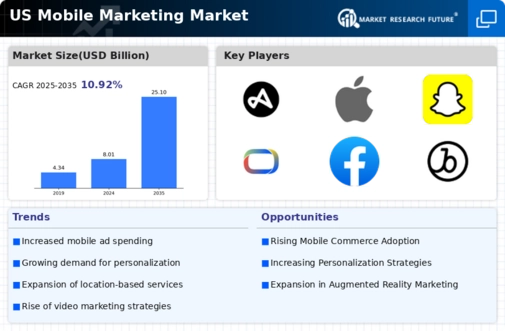Rising Smartphone Penetration
The increasing penetration of smartphones in the US is a pivotal driver for the mobile marketing. As of 2025, approximately 85% of the US population owns a smartphone, which facilitates direct engagement with consumers. This widespread adoption enables marketers to reach a larger audience through mobile channels. The mobile marketing market benefits from this trend as brands leverage mobile devices for targeted advertising, promotions, and customer engagement. Furthermore, the convenience of mobile shopping has led to a surge in mobile commerce, with estimates suggesting that mobile sales could account for over 50% of total e-commerce sales in the US. This shift underscores the importance of mobile marketing strategies that cater to the preferences of smartphone users, ultimately driving growth in the mobile marketing market.
Increased Mobile Internet Usage
The surge in mobile internet usage is a significant factor influencing the mobile marketing. As of November 2025, mobile devices account for over 70% of all internet traffic in the US, indicating a shift in consumer behavior towards mobile-first interactions. This trend compels marketers to optimize their strategies for mobile platforms, ensuring that content is accessible and engaging on smaller screens. The mobile marketing market is likely to see continued growth as businesses adapt to this reality, focusing on mobile-friendly websites and applications. Additionally, the rise of social media platforms, predominantly accessed via mobile devices, provides marketers with unique opportunities to engage with consumers in real-time. This dynamic environment suggests that mobile marketing strategies must evolve to capture the attention of an increasingly mobile-centric audience.
Advancements in Mobile Technology
Technological advancements in mobile devices and applications are driving innovation within the mobile marketing. The introduction of 5G technology enhances mobile internet speeds, allowing for richer media experiences and more interactive advertising formats. As of November 2025, 5G networks are becoming more widely available across the US, enabling marketers to experiment with augmented reality (AR) and virtual reality (VR) in their campaigns. These technologies offer immersive experiences that can significantly enhance consumer engagement. Furthermore, the integration of location-based services allows for hyper-targeted marketing, where businesses can deliver personalized content based on a user's geographic location. This capability is likely to transform how brands interact with consumers, making mobile marketing strategies more effective and relevant.
Growing Importance of Data Analytics
The increasing reliance on data analytics is reshaping the mobile marketing. Marketers are leveraging data to gain insights into consumer behavior, preferences, and trends, which informs their strategies. As of 2025, approximately 60% of marketers in the US report using data analytics tools to optimize their mobile campaigns. This trend indicates a shift towards data-driven decision-making, where businesses can tailor their marketing efforts based on real-time data. The ability to analyze user interactions and engagement metrics allows for continuous improvement of mobile marketing strategies. Consequently, companies that effectively utilize data analytics are likely to achieve higher conversion rates and improved return on investment (ROI) in their mobile marketing initiatives.
Expansion of Mobile Payment Solutions
The expansion of mobile payment solutions is a crucial driver for the mobile marketing. As of November 2025, mobile payment adoption in the US has reached approximately 45%, reflecting a growing consumer preference for convenient and secure payment methods. This trend encourages businesses to integrate mobile payment options into their marketing strategies, facilitating seamless transactions and enhancing customer experiences. The mobile marketing market is likely to benefit from this shift, as brands can promote special offers and loyalty programs directly through mobile payment platforms. Additionally, the rise of digital wallets and contactless payments aligns with consumer expectations for speed and convenience, further driving the need for effective mobile marketing strategies that cater to these preferences.

















Leave a Comment